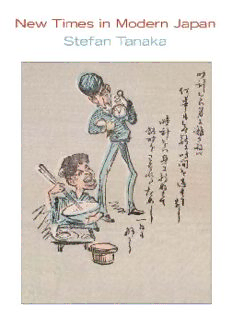
New Times in Modern Japan PDF
Preview New Times in Modern Japan
New Times in Modern Japan This page intentionally left blank New Times in Modern Japan Stefan Tanaka princeton university press princeton and oxford Copyright © 2004 by Princeton University Press Published by Princeton University Press, 41 William Street, Princeton, New Jersey 08540 In the United Kingdom: Princeton University Press, 3 Market Place, Woodstock, Oxfordshire OX20 1SY ALL RIGHTS RESERVED Library of Congress Cataloging-in-Publication Data Tanaka, Stefan. New times in modern Japan / Stefan Tanaka. p. cm. Includes bibliographical references and index. ISBN 0-691-11774-8 (cl : alk. paper) 1. Japan—History—Meiji period, 1868–1912. I. Title. DS882.T336 2004 952.03'1—dc22 2003066411 British Library Cataloging-in-Publication Data is available This book has been composed in Electra Printed on acid-free paper. pup.princeton.edu Printed in the United States of America 1 3 5 7 9 10 8 6 4 2 For Kyoko This page intentionally left blank CONTENTS Acknowledgments ix Prelude: Time, Pasts, History 1 Chapter1. Discovery of Pasts 27 Discovery One: Pasts prior to History 30 Discovery Two: Loss of Function 31 Discovery Three: The Archipelago Has a Past 39 Elevation of Time over Space 48 Chapter2. “Nothing Is the Way It Should Be” 54 Space of Experience: Shuten Doji 55 Nature as a Machine 60 (An)Other View: Durability of the Imprinted Form 65 “Secrets of the Human World”: Meiji Ghosts 69 Stories, Tales, History 76 Denigration of Experience 82 Chapter3. Naturalization of Nation: Essential Time 85 The Externalization of Nature 89 Like a Dragonfly: The Instability of Being Other 92 Spirituality from a Dead Past 101 Nature and Nation 108 Chapter4. Naturalization of Nation: Chronological Time 111 History as Histoire 114 Chronology: An Alibi of Time 118 Specters of History: National Literature and Art History 126 From Ghosts to Children: The Idea of Childhood 133 Conceptual Map 137 Chapter5. Socialization of Society 144 The “Social Problem” 147 A Cry for Experience as Experience 151 Contestation of Wills 160 The Socialization of a National Society 164 viii CONTENTS Chapter6. Socialization of Nature: Museumification 168 Frames 170 Nostalgia 177 Childhood 179 The Tutelary Complex 182 Ghostly Remnants? 190 Epilogue 193 Works Cited 203 Index 219 ACKNOWLEDGMENTS Writing the acknowledgments,a sort of biography of this book, is one of the true pleasures of the final stages of preparing a manuscript. It is one of those rituals that gives me a sense—no doubt mythical—that completion is near. In our dis- cipline such senses of completion are rare at best and, at times like this, fleeting. (Books are not completed, they are moments along an intellectual journey.) Thus it is a chance to review the long process that has led to this book; it is a re- minder of one of the best parts of history, the serendipity of following data and ideas whose import, as well as “mere” interest, are often unanticipated. This project began long ago after what seemed then as an odd request. In talk- ing to John Gillis about a paper for a conference on memory, he asked that I come up with a topic that dealt with something tangible. My work on art history began; more important, it directed me more toward an inquiry into what I now see as the materiality of ideas. Two other conferences were especially and unex- pectedly pivotal, again turning this project away from what I thought it was going to be. I am thankful to Sally Humphreys for stimulating what has become my work on childhood. Another unexpected turn arose when Kevin Doak re- fused my initial suggestion for a paper. A paper on the Horyuji came out of what at the time, I thought, was a throwaway line. The ideas in this book developed through contact with many colleagues who invited me to present my preliminary work at the University of Chicago, Washington University, the German Histori- cal Institute, Tokyo National Research Institute of Cultural Properties, University of California at Los Angeles, and the Exploratorium in San Francisco. This project was supported by many institutions. A research fellowship from the National Endowment for the Humanities was very important in getting it off the ground. An Andrew Mellon postdoctoral fellowship at the University of Southern California gave me some conceptual room to allow for reading and thinking. I thank Clark University and the University of California, San Diego, both of which provided research support. An International and Area Studies Fel- lowship from the American Council of Learned Societies, Social Science Re- search Council, and National Endowment for the Humanities in 2000 allowed me to spend a year pulling all the parts together. This book is a reformulation of some previously published materials, the re- sult of conferences that stimulated me to explore new issues. I am thankful to the publishers for allowing me to use the following essays: “Imaging History: In- scribing Belief in the Nation,” Journal of Asian Studies 53 (1994): 24–44; “Childhood: the Naturalization of Development into a Japanese Space,” in S.C. Humphreys, ed., Cultures of Scholarship(Ann Arbor: University of Michi- gan Press, 1997); “Discoveries of the Horyuji,” in Kai-wing Chow, Kevin M.
Description: